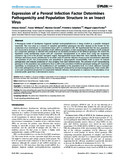Mostrar el registro sencillo del ítem
Expression of a peroral infection factor determines pathogenicity and population structure in an insect virus
| dc.creator | Simón de Goñi, Oihane | es_ES |
| dc.creator | Williams, Trevor | es_ES |
| dc.creator | Cerutti, Martine | es_ES |
| dc.creator | Caballero Murillo, Primitivo | es_ES |
| dc.creator | López Ferber, Miguel | es_ES |
| dc.date.accessioned | 2018-09-06T12:20:26Z | |
| dc.date.available | 2018-09-06T12:20:26Z | |
| dc.date.issued | 2013 | |
| dc.identifier.issn | 1932-6203 | |
| dc.identifier.uri | https://hdl.handle.net/2454/30566 | |
| dc.description.abstract | A Nicaraguan isolate of Spodoptera frugiperda multiple nucleopolyhedrovirus is being studied as a possible biological insecticide. This virus exists as a mixture of complete and deletion genotypes; the latter depend on the former for the production of an essential per os transmission factor (pif1) in coinfected cells. We hypothesized that the virus population was structured to account for the prevalence of pif1 defector genotypes, so that increasing the abundance of pif1 produced by a cooperator genotype in infected cells would favor an increased prevalence of the defector genotype. We tested this hypothesis using recombinant viruses with pif1 expression reprogrammed at its native locus using two exogenous promoters (egt, p10) in the pif2/pif1 intergenic region. Reprogrammed viruses killed their hosts markedly faster than the wild-type and rescue viruses, possibly due to an earlier onset of systemic infection. Group success (transmission) depended on expression of pif1, but overexpression was prejudicial to group-specific transmissibility, both in terms of reduced pathogenicity and reduced production of virus progeny from each infected insect. The presence of pif1-overproducing genotypes in the population was predicted to favor a shift in the prevalence of defector genotypes lacking pif1-expressing capabilities, to compensate for the modification in pif1 availability at the population level. As a result, defectors increased the overall pathogenicity of the virus population by diluting pif1 produced by overexpressing genotypes. These results offer a new and unexpected perspective on cooperative behavior between viral genomes in response to the abundance of an essential public good that is detrimental in excess. | en |
| dc.description.sponsorship | This study received financial support from the Spanish Ministry for Science and Technology projects AGL2005-07909-CO3-01 and AGL2008-05456-CO3- 01/AGR. O.S. received a Jose´ Castillejo grant for postdoctoral mobility. | en |
| dc.format.mimetype | application/pdf | en |
| dc.format.mimetype | application/zip | en |
| dc.language.iso | eng | en |
| dc.publisher | Public Library of Science | en |
| dc.relation.ispartof | Plos One, 8(11): e78834 | en |
| dc.rights | © 2013 Simón et al. This is an open-access article distributed under the terms of the Creative Commons Attribution License, which permits unrestricted use, distribution, and reproduction in any medium, provided the original author and source are credited. | en |
| dc.rights.uri | https://creativecommons.org/licenses/by/3.0/ | |
| dc.subject | PIF factors | en |
| dc.subject | Spodoptera frugiperda multiple nucleopolyhedrovirus | en |
| dc.subject | Biological insecticides | en |
| dc.title | Expression of a peroral infection factor determines pathogenicity and population structure in an insect virus | en |
| dc.type | info:eu-repo/semantics/article | en |
| dc.type | Artículo / Artikulua | es |
| dc.contributor.department | Producción Agraria | es_ES |
| dc.contributor.department | Nekazaritza Ekoizpena | eu |
| dc.contributor.department | IdAB. Instituto de Agrobiotecnología / Agrobioteknologiako Institutua | es |
| dc.rights.accessRights | info:eu-repo/semantics/openAccess | en |
| dc.rights.accessRights | Acceso abierto / Sarbide irekia | es |
| dc.identifier.doi | 10.1371/journal.pone.0078834 | |
| dc.relation.publisherversion | https://doi.org/10.1371/journal.pone.0078834 | |
| dc.type.version | info:eu-repo/semantics/publishedVersion | en |
| dc.type.version | Versión publicada / Argitaratu den bertsioa | es |



